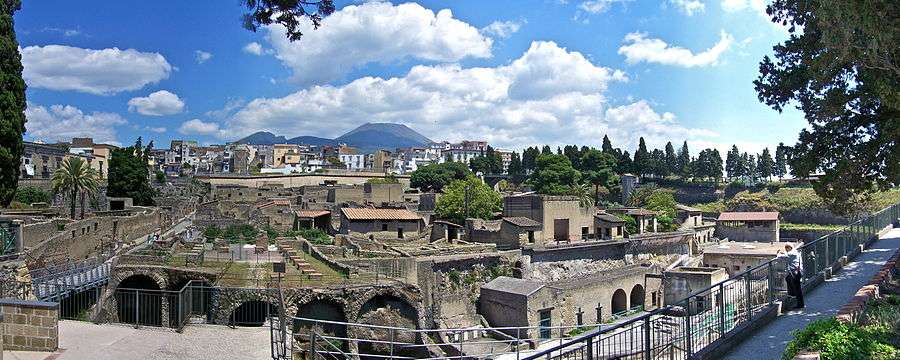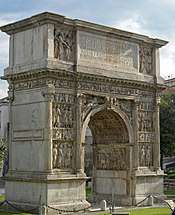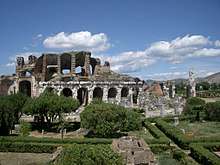Herculaneum
Herculaneum /hɜːrkjʊˈleɪniəm/ (Italian: Ercolano) was an ancient town, located in the modern-day comune of Ercolano, Campania, Italy. The city was destroyed and buried under volcanic ash and pumice in the eruption of Mount Vesuvius in 79 AD.
.jpg) The excavations of Ercolano | |
 Shown within Italy | |
| Alternative name | Ercolano |
|---|---|
| Location | Ercolano, Campania, Italy |
| Coordinates | 40.8060°N 14.3482°E |
| Type | Settlement |
| History | |
| Founded | 6th – 7th century BC |
| Abandoned | 79 AD |
| Site notes | |
| Website | Herculaneum – Official website |
| Official name | Archaeological Areas of Pompeii, Herculaneum, and Torre Annunziata |
| Type | Cultural |
| Criteria | iii, iv, v |
| Designated | 1997 (21st session) |
| Reference no. | 829 |
| Region | Europe and North America |
Like the nearby city of Pompeii, Herculaneum is famous as one of the few ancient cities to be preserved more or less intact, with no later accretions or modifications. The thick layer of ash that blanketed the town also protected it against looting and the elements. Unlike Pompeii, the mainly pyroclastic material that covered Herculaneum carbonized and preserved more wood in objects such as roofs, beds, and doors, as well as other organic-based materials such as food and papyrus.
The traditional story is that the city was rediscovered by chance in 1709, during the digging of a well. Remnants of the city, however, were already found during earlier earthworks.[1] In the first years after its rediscovery, tunnels were dug at the site by treasure hunters, and many artifacts were removed without authorization. Regular excavations began in 1738, and have continued ever since, albeit intermittently. Today, only part of the ancient site has been excavated, and attention and funds have shifted to the preservation of the already excavated parts of the city, rather than focusing on uncovering more areas.
Although it was smaller than Pompeii, Herculaneum was a wealthier town.[2] It was a popular seaside retreat for the Roman elite, which is reflected in the extraordinary density of grand and luxurious houses with, for example, far more lavish use of coloured marble cladding. Famous buildings of the ancient city include the Villa of the Papyri and the so-called "boat houses", in which the skeletal remains of at least 300 people were found.
History of Herculaneum
_(14596114730).jpg)
Ancient tradition[3] connected Herculaneum with the Greek hero Heracles (Hercules in Latin[4]) an indication that the city was of Greek origin. The inhabitants worshipped principally Hercules as the founder of both the town and Mount Vesuvius. Other important deities worshipped include Venus and Apollo represented in many statues in the city.
According to Strabo the Oscans founded the first settlement at Herculaneum.[5] They were followed by Etruscan and then Greek control. The Greeks named the town Heraklion and used the town as a trading post because of its proximity to the Gulf of Naples. In the 4th century BC, Herculaneum came under the domination of the Samnites until it became a Roman municipium in 89 BC, when, having participated in the Social War ("War of The Allies" against Rome), it was defeated by Titus Didius, a legate of Sulla.
After the eruption of Mount Vesuvius in 79 AD, the town of Herculaneum was buried under approximately 20 metres (50–60 feet) of ash. It lay hidden and largely intact until discoveries from wells and tunnels became gradually more widely known, and notably following the Prince d'Elbeuf's explorations in the early 18th century.[6] Excavations continued sporadically up to the present and today many streets and buildings are visible, although over 75% of the town remains buried. Today, the Italian towns of Ercolano and Portici lie on the approximate site of Herculaneum. Until 1969 the town of Ercolano was called Resina. It changed its name to Ercolano, the Italian modernisation of the ancient name in honour of the old city.
The eruption of 79 AD

Based on archaeological excavations and on two letters of Pliny to the Roman historian Tacitus, the course of the eruption can be reconstructed.[7]
At around 1:00 pm, Mount Vesuvius began spewing volcanic material thousands of metres into the sky. When it reached the tropopause, the top of the column flattened, prompting Pliny to describe it to Tacitus as a stone pine tree. The prevailing winds at the time blew toward the southeast, causing the volcanic material to fall primarily on the city of Pompeii and the surrounding area. Since Herculaneum lay to the west of Vesuvius, it was only mildly affected by the first phase of the eruption. While roofs in Pompeii collapsed under the weight of falling debris, only a few centimetres of ash fell on Herculaneum, causing little damage but nonetheless prompting most inhabitants to flee.
At 1:00 am the next day, the eruptive column, which had risen into the stratosphere, collapsed onto Vesuvius and its flanks. The first pyroclastic surge, formed by a mixture of ash and hot gases, flowed down the mountain and through the mostly evacuated town of Herculaneum at 160 km/h (100 mph). A succession of six flows and surges buried the city's buildings, causing little damage in some areas and preserving structures, objects and victims almost intact. However, in other areas there was significant damage, knocking down walls, tearing away columns and other large objects;[8] a marble statue of Marcus Nonius Balbus near the baths was blown 15 m away and a carbonised skeleton was found lifted 2.5 m above ground level in the garden of the House of the Relief of Telephus.[9]
The date of the eruption has been shown to be on or after 17 October.[10] Further support for an October/November eruption has long been known in several respects: buried people in the ash were wearing heavier clothing than the light summer clothes typical of August; fresh fruit and vegetables in the shops are typical of October – and conversely the summer fruit typical of August was already being sold in dried, or conserved form. Wine fermenting jars had been sealed, which would have happened around the end of October; coins found in the purse of a woman buried in the ash include one with a 15th imperatorial acclamation among the emperor's titles and could not have been minted before the second week of September.[11]
Recent multidisciplinary research on the lethal effects of the pyroclastic surges in the Vesuvius area showed that in the vicinity of Pompeii and Herculaneum, heat was the main cause of the death of people who had previously been thought to have died by ash suffocation. This study shows that exposure to the surges, measuring at least 250 °C (480 °F) even at a distance of 10 kilometres from the vent, was sufficient to cause the instant death of all residents, even if they were sheltered within buildings.[12]
Archaeology

The Prince d'Elbeuf began building a villa at nearby Granatello and to furnish it became interested in local stories of wells revealing ancient statues and works of art.[13] In 1709 he purchased the land of a recent well and proceeded to tunnel out from the bottom of the well, collecting any statues they could find. The well revealed some exceptional statues at the lowest levels which were found to be the site of the theatre. Among the earliest statues recovered were the two superbly sculpted Herculaneum Women[14] now in the Dresden Skulpturensammlung.[15] The excavation was stopped in 1711 for fear of collapse of buildings above.
Major excavation was resumed in 1738 under the patronage of Charles III of Spain when he started construction of his nearby palace at Portici. He employed Spanish military engineer Rocque Joaquin de Alcubierre to oversee the intensive new work. The resulting elaborate publication of Le Antichità di Ercolano ("The Antiquities of Herculaneum") had an effect on incipient European Neoclassicism out of all proportion to its limited circulation; in the later 18th century, motifs from Herculaneum began to appear on stylish furnishings, from decorative wall-paintings and tripod tables to perfume burners and teacups. However, excavation ceased after strong criticism in 1762 by Winckelmann of the treasure-hunting methods employed, and once the nearby town of Pompeii was discovered which was significantly easier to excavate because of the thinner layer of debris covering the site (4 m as opposed to Herculaneum's 20 m).
In 1828 under the new king Francis I, new excavations were begun in order to expose the remains to the open air and land was purchased, though this was stopped in 1837. Under the Italian government in 1868 further purchases of land were made and excavations proceeded eastwards till 1875.[16]
From 1927 until 1942 a new campaign of excavations was begun by Amedeo Maiuri under the Mussolini regime, which exposed about four hectares of the ancient city in the archaeological park that is visible today.
Excavation resumed briefly in the town in 1980–81 on the ancient shoreline following which the skeletons in the so-called "boat houses" were found.
From 1996–99 the large area to the north-west of the site was excavated and exposed, including part of the Villa of the Papyri, the north-west baths,[17] the House of the Dionysian Reliefs[18] and a large collapsed monument. This area was left in a chaotic state and from 2000–7 further work on conservation of this area was done.
Many public and private buildings, including the forum complex, are yet to be excavated.
The site
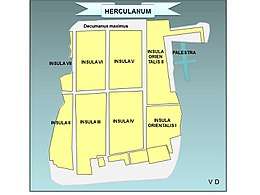
The classical street layout separates the city into blocks (insulae), defined by the intersection of the east–west (cardi) and north–south (decumani) streets. Hence Insula II – Insula VII run counterclockwise from Insula II. To the east are two additional blocks: Orientalis I (oI) and Orientalis II (oII). To the south of Orientalis I (oI) lies one additional group of buildings known as the "Suburban District" (SD). Individual buildings having their own entrance number. For example, the House of the Deer is labelled (Ins IV, 3).
The Forum, temples, theatre, numerous houses and necropolises are still buried in Herculaneum.
The town was surrounded by walls of thickness from 2 to 3 metres and built mainly with large pebbles, dating to the second century BC, while along the coast they were in opus reticulatum. As in Pompeii, the walls lost their defensive function after the social wars and were incorporated into buildings in their vicinity, for example the House of the Inn.
A single main drain was found, along cardo III, which collected water from the Forum and from house impluviums, latrines and kitchens that overlooked this street, while other drains emptied directly into the street, except those of the latrines that were equipped with a cess pit. For water supply the city was directly connected to the Serino aqueduct, built in the Augustan age, which brought water to houses through a series of lead pipes under the roads, regulated by valves; previously, wells had been used which found water at a depth of between eight and ten metres.
The House of Aristides (Ins II, 1)
The first building in insula II is the House of Aristides. The entrance opens directly onto the atrium, but the remains of the house are not particularly well preserved due to damage caused by previous excavations. The lower floor was probably used for storage.
The House of Argus (Ins II, 2)
The second house in insula II got its name from a fresco of Argus and Io which once adorned a reception room off the large peristyle. The fresco is now lost, but its name lives on. This building must have been one of the finer villas in Herculaneum. The discovery of the house in the late 1820s was notable because it was the first time a second floor had been unearthed in such detail. The excavation revealed a second floor balcony overlooking Cardo III, as well as wooden shelving and cupboards; however, with the passing of time, these elements have been lost.
The House of the Genius (Ins II, 3)
To the north of the House of Argus lies the House of the Genius. It has been only partially excavated but it appears to have been a spacious building. The house derives its name from the statue of a cupid that formed part of a candlestick. In the centre of the peristyle are the remains of a rectangular basin.
The House of the Alcove (Ins IV)
The house is actually two buildings joined together. As a consequence of this it is a mixture of plain and simple rooms combined with some highly decorated ones.
The atrium is covered, so lacks the usual impluvium. It retains its original flooring of opus tesselatum and opus sectile. Off the atrium is a biclinium richly decorated with frescoes in the fourth style and a large triclinium which originally had a marble floor. A number of other rooms, one of which is the apsed alcove after which the house was named, can be reached via a hall which gets its light from a small courtyard.
College of the Augustales
Temple of the augustales or priests of the Imperial cult.
Central Thermae
The Central Thermae were bath houses built around the first century AD. Bath houses were very common at that time, especially in Pompeii and Herculaneum. Per common practice, there were two different bath areas, one for men and the other for women. These houses were extremely popular, attracting many visitors daily. This cultural hub was also home to several works of art, which can be found in various areas of the Central Thermae site.
Villa of the Papyri
The most famous of the luxurious villas at Herculaneum is the "Villa of the Papyri." It was once identified as the magnificent seafront retreat for Lucius Calpurnius Piso Caesoninus, Julius Caesar's father-in-law; however, the objects thought to be associated with Lucius Calpurnius Piso Caesonius correspond more closely to a greatly standardized assemblage, and cannot indicate, with certainty, the owner of the villa.[19] The villa stretches down towards the sea in four terraces. Piso, a literate man who patronized poets and philosophers, built a fine library there, the only one to survive intact from antiquity.
Between 1752 and 1754 a number of blackened unreadable papyrus scrolls were serendipitously recovered from the Villa of the Papyri by workmen. These scrolls became known as the Herculaneum papyri or scrolls, the majority of which are today stored at the National Library, Naples. The scrolls are badly carbonized, but a large number have been unrolled, with varying degrees of success. Computer-enhanced multi-spectral imaging, in the infra-red range, helps make the ink legible. There is now a real prospect that it will be possible to read the unopened rolls using X-rays.[20] The same techniques could be applied to the rolls waiting to be discovered in the as-yet unexcavated part of the villa, eliminating the need for potentially damaging the rolls by unrolling them. In a later attempt to better read the writings on the scrolls, scientists put the scrolls through a CT scan. From this scan, scientists were able to see the structure of the scrolls' fiber, and see the sand and other dirt that had gotten into the scrolls through the years. Knowing the scrolls' structure made it easier to unroll without breaking. However, the text on the scrolls was still illegible.[21]
A team spent a month in summer 2009, making numerous X-ray scans of two of the rolls that are stored at the French National Academy in Paris. They hoped that computer processing would convert the scans into digital images showing the interiors of the rolls and revealing the ancient writing. The main fear, however, was that the Roman writers might have used carbon-based inks, which would be essentially invisible to the scans. That fear has turned out to be fact. They had hoped that re-scanning the rolls with more powerful X-ray equipment would reveal the text.[22] However, subsequent X-rays produced nothing legible.[23]
In 2015, a group of researchers headed by Italian physicist Vito Mocella used the method of X-ray phase-contrast tomography, which allowed scientists to increase the contrast between the carbon ink and the carbon based papyrus so that the words could be read along the outer surface of the papyrus. Scientists were able to read the words written in Greek on the scrolls, marking the beginning of "a revolution for papyrologists". While researchers can identify certain words on the scrolls, there is still a long way to go before the stories on the scrolls are unlocked.[24]
Skeletal remains
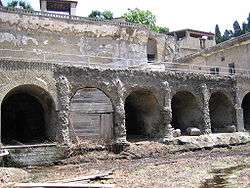

In 1980–82, under site administrator Dr. Giuseppe Maggi, excavations initially turned up more than 55 skeletons on the beach and in the first six so-called boat sheds.[25] Because earlier excavations had revealed only a few skeletons, it was long thought that nearly all of the inhabitants had managed to escape, but this surprising discovery led to a change of view. The last inhabitants waiting for rescue from the sea were killed instantly by the intense heat, despite being sheltered from direct impact. The study of victims' postures and the effects on their skeletons indicate that the first surge caused instant death as a result of fulminant shock due to a temperature of about 500 °C (930 °F). The intense heat caused contraction of hands and feet and possibly fracture of bones and teeth.[26]
After a period of mismanagement of the finds and deterioration of skeletons[27] further excavations in the 1990s revealed a total of 296 skeletons huddled close together in twelve arches facing the sea and on the beach, while the town was almost completely evacuated. The "Ring Lady" (see image), named for the rings on her fingers, was discovered in 1982.
Chemical analysis of the remains has led to greater insight into the health and nutrition of the Herculaneum population. Dr. Sara C. Bisel (1932–1996) was a physical anthropologist and classical archaeologist who played a prominent role in early scientific research at Herculaneum. Her pioneering work in the chemical and physical analysis of skeletons yielded new insights into the nutrition and health of ancient populations. This was considered ground-breaking and helped advance the field of paleodemography. Quantities of lead were found in some of the skeletons, which led some to speculation of lead poisoning. Also the presence of scarring on the pelvis, for instance, may give some indication of the number of children a woman had borne.[28]
Casts of skeletons were also produced, to replace the original bones after taphonomic study, scientific documentation and excavation. In contrast to Pompeii, where casts resembling the body features of the victims were produced by filling the body imprints in the ash deposit with plaster, the shape of corpses at Herculaneum could not be preserved, due to the rapid vapourization and replacement of the flesh of the victims by the hot ash (ca. 500 °C). A cast of the skeletons unearthed within chamber 10 is on display at the Museum of Anthropology in Naples.[29]
Dangers to the site
Natural Disaster
As of 2015, some volcanologists believe that Vesuvius has the potential for another eruption like the one of 79 AD. From looking at seismic waves of earthquakes under the volcano, it is believed that there could be magma (molten material) 8 to 10 km below the volcano, but it is unclear whether or not this magma has the potential to erupt.[30]
Bradyseism
In 79 AD Herculaneum was a coastal town that sat just above sea level. Now certain areas of the ancient city are located as much as 4 metres below the current sea level. While the Herculaneum Conservation Project has implemented a drainage system that keeps water from collecting in the city and causing further damage to the site, Bradyseism has caused the land to sink in the vicinity.[31]
There may come a time when the current drainage system is rendered ineffective. Climate change may eventually also have an effect on sea level rise as elsewhere.
Issues of conservation
The volcanic ash and debris covering Herculaneum, along with the extreme heat, left it in a remarkable state of preservation for over 1600 years. However, once excavations began, exposure to the elements began the slow process of deterioration. This was not helped by the methods of archaeology used earlier in the town's excavation, which generally centered around recovering valuable artifacts rather than ensuring the survival of all artifacts. In the early 1980s and under the direction of Dr. Sara C. Bisel, preservation of the skeletal remains became a high priority. The carbonised remains of organic materials, when exposed to the air, deteriorated over a matter of days, and destroyed many of the remains until a way of preserving them was formed.
Today, tourism and vandalism have damaged many of the areas open to the public, and water damage coming from the modern Ercolano has undermined many of the foundations of the buildings. Reconstruction efforts have often proved counterproductive. However, in modern times conservation efforts have been more successful. Today excavations have been temporarily discontinued, in order to direct all funding to help save the city.
A large number of artifacts from Herculaneum are preserved in the Naples National Archaeological Museum.
Modern conservation
After years of mismanagement, Herculaneum fell into a dire state. However, in 2001, the Packard Humanities Institute began the Herculaneum Conservation Project, a private-public partnership. Initially the project set out to provide financial aid to the local authorities and address the truly critical areas of the site. Over time the goal changed to not only providing financial aid but to providing resources and skilled experts who could better tend to the site. The team went from addressing emergency conservation issues to creating a formula for the long term betterment of the site. Since 2001, the Herculaneum Conservation Project has been involved in multiple pilot conservation projects and has partnered with the British School in Rome to actively teach students how to maintain the site.[32]
One of the pilot projects started by the Conservation Project was on the tablinum that had been conserved by Maiuri's team in 1938. Over time water had managed to seep into the wall causing the paint to attach to the previously applied wax and curl away from the wall, stripping it of its color. However, after working in tandem with the Getty Museum, conservators have managed to create a technique where a series of solvents can be used to remove some of the wax and lessen the amount of buildup on the walls so that the paint no longer chips off of the walls.[33]
While the conservation efforts are still ongoing, Herculaneum has gone from one of the worst preserved UNESCO sites at risk of being put on the endangered list to becoming "a textbook case of successful archeological conservation".[34]
Photos
 House Number 22 is noted for this outstanding summer triclinium with a nymphaeum decorated with coloured mosaics
House Number 22 is noted for this outstanding summer triclinium with a nymphaeum decorated with coloured mosaics Herculaneum, Neptune and Salacia, wall mosaic in House Number 22
Herculaneum, Neptune and Salacia, wall mosaic in House Number 22 Street paving stones in Herculaneum
Street paving stones in Herculaneum Residential water pipe made of lead in Herculaneum
Residential water pipe made of lead in Herculaneum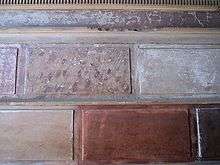 Wall paintings in the first style
Wall paintings in the first style Inlaid marble floor
Inlaid marble floor Marcus Nonius Balbus, found in dwellings of Resina/Herculaneum.
Marcus Nonius Balbus, found in dwellings of Resina/Herculaneum.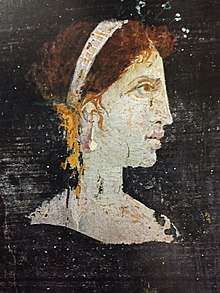
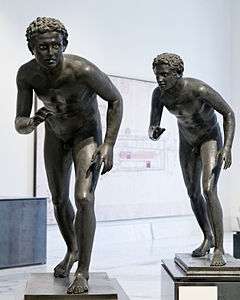 Bronze sculptures of runners from the Villa of the Papyri at Herculaneum, now in the Naples National Archaeological Museum
Bronze sculptures of runners from the Villa of the Papyri at Herculaneum, now in the Naples National Archaeological Museum
Documentaries
- A 1987 National Geographic special In the Shadow of Vesuvius explored the sites of Pompeii and Herculaneum, interviewed archaeologists, and examined the events leading up to the eruption of Vesuvius.
- A 2002 documentary "Herculaneum. An unlucky escape" – http://www.doclab.it/produzioni.php, based on a research of Pier Paolo Petrone, Giuseppe Mastrolorenzo and Mario Pagano. Co-production of DocLab Rome, Discovery Channel USA, France 3 – Taxi Brousse, Spiegel TV, Mediatred, 52'.
- A 2004 documentary "Pompeii and the 79 AD eruption". TBS Channel Tokyo Broadcasting System, 120'.
- An hour-long drama produced for the BBC entitled Pompeii: The Last Day portrays several characters (with historically attested names, but fictional life-stories) living in Pompeii, Herculaneum and around the Bay of Naples, and their last hours, including a fuller and his wife, two gladiators, and Pliny the Elder. It also portrays the facts of the eruption.
- Pompeii Live, Channel 5, 28 June 2006, 8pm, live archaeological dig at Pompeii and Herculaneum
- Marcellino de Baggis' 2007 documentary "Herculaneum: Diaries of Darkness and Light", Onionskin productions[37]
- A 2007 documentary "Troja ist überall: Auferstehung am Vesuv", Spiegel TV, 43'29 – http://terra-x.zdf.de/ZDFde/inhalt/3/0,1872,7122307,00.html.
- Secrets of the Dead: Herculaneum Uncovered is a PBS show covering the archaeological discoveries at Herculaneum.
- Out of the Ashes: Recovering the Lost Library of Herculaneum is a KBYU-TV documentary that traces the history of the Herculaneum papyri from the time of the eruption, to their discovery in 1752, to modern developments that impact their study.
- The Other Pompeii: Life and Death in Herculaneum is a documentary presented by Andrew Wallace-Hadrill, director of Herculaneum Conservation Project.
- Pompeii: The Mystery of the People Frozen in Time is a 2013 BBC One drama documentary presented by Dr. Margaret Mountford.
Notes
- Wallace-Hadrill, Andrew (2011). Herculaneum: Past and Future. ISBN 978-0-7112-3142-9. p47
- Wallace-Hadrill, Andrew (2011). Herculaneum: Past and Future. ISBN 978-0-7112-3142-9. p55
- Dionysius of Halicarnassus: Antiquitates Romanae 44
- The founding myth asserted that Hercules built Herculaneum at the location where he killed Cacus, a son of Vulcan who had stolen some of Hercules' cattle
- Strabo, Geography V, 4, 8
- Wallace-Hadrill, Andrew (2011). Herculaneum: Past and Future. ISBN 978-0-7112-3142-9.
- Available at the University of Arizona: Pliny the Younger, Letters 6.16 and 6.20 to Cornelius Tacitus and in Project Gutenberg: Letter LXV — To Tacitus, Letter LXVI — To Cornelius Tacitus
- http://www.herculaneum.ox.ac.uk/files/newsletters/harchissue2.pdf p 3
- "House of the Relief of Telephus – AD79eruption". sites.google.com.
- "Pompeii's destruction date could be wrong". BBC News. 16 October 2018.
- Stefani, Grete (October 2006). La vera data dell'eruzione. Archeo
- Mastrolorenzo, G; Petrone, P; Pappalardo, L; Guarino, FM (15 June 2010). "Lethal thermal impact at periphery of pyroclastic surges: evidences at Pompeii". PLOS One. 5 (6): e11127. Bibcode:2010PLoSO...511127M. doi:10.1371/journal.pone.0011127. PMC 2886100. PMID 20559555.
- Wallace-Hadrill, Andrew (2011). Herculaneum: Past and Future. ISBN 978-0-7112-3142-9. p47
- THE LARGE AND THE SMALL HERCULANEUM WOMAN, Universita Ca' Foscari, Venezia, Doctoral Thesis 2014–2015, Angeliki Ntontou
- The Herculaneum Women: And the Origins of Archaeology (J. Paul Getty Museum) – 7 Feb 2008, Daehner
- Wallace-Hadrill, Andrew (2011). Herculaneum: Past and Future. ISBN 978-0-7112-3142-9. p62
- "Northwest Baths – AD79eruption". sites.google.com.
- "House of the Dionysian Reliefs – AD79eruption". sites.google.com.
- The World of Pompeii. Edited by John J. Dobbins and Pedar W. Foss 2008
- "Digital Exploration: Unwrapping the Secrets of Damaged Manuscripts". www.research.uky.edu. Archived from the original on 1 February 2006. Retrieved 16 December 2016.
- Banerji, Robin (20 December 2013). "Unlocking the scrolls of Herculaneum". BBC News. Retrieved 27 December 2018.
- "UK scientists stymied in effort to read ancient scrolls". kentucky. Retrieved 16 December 2016.
- "UK scientists stymied in effort to read ancient scrolls". kentucky. Retrieved 16 December 2016.
- Hammer, Joshua. "The Fall and Rise and Fall of Pompeii". Smithsonian. Retrieved 27 December 2018.
- S. C. Bisel, "The skeletons of Herculaneum, Italy", in B. A. Purdy (ed.), Wet Site Archaeology, Caldwell, NJ, 1988, pp. 207–18
- Mastrolorenzo, G.; Petrone, P.P.; Pagano, M.; Incoronato, A.; Baxter, P.J.; Canzanella, A.; Fattore, L. (2001). "Herculaneum Victims of Vesuvius in AD 79". Nature. 410 (6830): 769–770. Bibcode:2001Natur.410..769M. doi:10.1038/35071167. PMID 11298433.
- Wallace-Hadrill, Andrew (2011). Herculaneum: Past and Future. p. 126 ISBN 978-0-7112-3142-9
- Recently Dr Estelle Lazer of the University of Sydney has questioned some of these findings in Resurrecting Pompeii (2009).
- Capasso, Luigi (2001). I fuggiaschi di Ercolano. Paleobiologia delle vittime dell' eruzione vesuviana del 79 d.C. Rome: L'Erma di Bretschneider.
- Klemetti, Erik (19 March 2015). "Over 70 Years of Silence from Italy's Vesuvius". Wired. ISSN 1059-1028. Retrieved 27 December 2018.
- Cinque, A. and Irollo, G. (2008) "Lapaleogeografia dell’antica Herculaneum e lefluttuazioni, di origine bradisismica, dellasua linea di costa". In P. G. Guzzo andM. P. Guidobaldi, eds., Nuove ricerche archeologiche nell’area Vesuviana (scavi 2003–2006): 425–38
- Project, Herculaneum Conservation. "The Herculaneum Conservation Project: an introduction". Cite journal requires
|journal=(help) - "Herculaneum Project". www.getty.edu. Retrieved 27 December 2018.
- Povoledo, Elisabetta (14 November 2012). "Herculaneum's Ruins Are Revived by Philanthropy". The New York Times. ISSN 0362-4331. Retrieved 27 December 2018.
- Walker, Susan; Higgs, Peter (2001), "Painting with a portrait of a woman in profile", in Walker, Susan; Higgs, Peter (eds.), Cleopatra of Egypt: from History to Myth, Princeton, N.J.: Princeton University Press (British Museum Press), pp. 314–315, ISBN 9780691088358.
- Fletcher, Joann (2008). Cleopatra the Great: The Woman Behind the Legend. New York: Harper. ISBN 978-0-06-058558-7, image plates and captions between pp. 246-247.
- Herculaneum: DVD: Diaries of Light and Darkness. WorldCat. Online Computer Library Center, Inc. OCLC 277147385.
Further reading
- Brennan, B. 2018.Herculaneum A Roman Town Reborn. Sydney: Ancient History Seminars.
- Brennan, B. 2012. Herculaneum A Sourcebook. Sydney: Ancient History Seminars.
- Capasso, L. 2001. I fuggiaschi di Ercolano. Paleobiologia delle vittime dell' eruzione vesuviana del 79 d.C. Roma: L'Erma di Bretschneider
- Daehner, J., ed. 2007. The Herculaneum Women: History, Context, Identities. Los Angeles: J. Paul Getty Museum.
- De Carolis, E., and G. Patricelli. 2003. Vesuvius, A.D. 79: The Destruction of Pompeii and Herculaneum. Los Angeles: J. Paul Getty Museum.
- Deiss, J. J. 1995. The Town of Hercules: A Buried Treasure Trove. Malibu, CA: J. Paul Getty Museum.
- Lazer, E. 2009. Resurrecting Pompeii. London: Routledge.
- Pace, S. 2000. Herculaneum and European Culture Between the Eighteenth and Nineteenth Centuries. Naples, Italy: Electa.
- Pagano, M. 2000. Herculaneum: A Reasoned Archaeological Itinerary. Translated by A. Pesce. Naples, Italy: T&M.
- Pagano, M., and A. Balasco. 2000. The Ancient Theatre of Herculaneum. Translated by C. Fordham. Naples, Italy: Electa.
- Pirozzi, M. E. A. 2000. Herculaneum: The Excavations, Local History and Surroundings. Naples, Italy : Electa.
- Scarth, A. 2009. Vesuvius: A Biography. Princeton, NJ: Princeton University Press.
- Wallace-Hadrill, A. 2011. "The Monumental Centre of Herculaneum: In Search of the Identities of the Public Buildings." Journal of Roman Archaeology 24:121–160.
References
- National Geographic, Vol 162, No. 6. Buried Roman Town Give Up Its Dead, (December, 1982)
- National Geographic, Vol 165, No 5. The Dead Do Tell Tales, (May, 1984)
- Discover, magazine, Vol 5, No. 10. The Bone Lady (October, 1984)
- The Mayo Alumnus, Vol 19, No. 2. An Archaeologist's Preliminary Report: Time Warp at Herculaneum, (April, 1983)
- Carnegie Mellon Magazine, Vol 4, No. 2. Bone Lady Reconstructs People at Herculaneum, Winter, 1985
- In the Shadow of Vesuvius National Geographic Special, (11 February 1987)
- 30 years of National Geographic Special, (25 January 1995)
- Petrone P.P., Fedele F. (a cura di), 2002. Vesuvio 79 A.D. Vita e morte ad Ercolano, Fridericiana Editrice Universitaria, Napoli.
- Antonio Virgili, Culti misterici ed orientali a Pompei, Gangemi, Roma, 2008.
- National Geographic, Vol 212, No. 3. Vesuvius. Asleep for Now, (September, 2006) http://ngm.nationalgeographic.com/2007/09/vesuvius/vesuvius-text
Resources
- Pliny the Younger's letters on the catastrophic eruption of Mt. Vesuvius in 79 A.D. to the Roman historian Tacitus from University of Arizona: Pliny the Younger, Letters 6.16 and 6.20 to Cornelius Tacitus and in Project Gutenberg: Letter LXV – To Tacitus, Letter LXVI – To Cornelius Tacitus
External links
| Wikivoyage has a travel guide for Herculaneum. |
| Wikimedia Commons has media related to Ercolano. |
| Library resources about Herculaneum |
- The local archaeological authorities – Official website
- Herculaneum Conservation Project – Official website
- AD 79: Year of Destruction
- 62 Pompeii earthquake
- Herculaneum papyri
- Blogging Pompeii
- The Friends of Herculaneum Society
- The Philodemus Project will publish Philodemus' works on poetry and on rhetoric.
- Brigham Young University: Herculaneum Scrolls
- Herculaneum by Iain Dickson, 'Melvadius Macrinus Cugerni'
- Herculaneum Uncovered Documentary produced by the PBS Series Secrets of the Dead
- Purcell, N., R. Talbert, T. Elliott, S. Gillies. "Places: 432873 (Herculaneum)". Pleiades. Retrieved 8 March 2012.CS1 maint: multiple names: authors list (link)
- Romano-Campanian Wall-Painting (English, Italian, Spanish and French introduction)
- "Herculaneum Uncovered – A conversation with Andrew Wallace-Hadrill", Ideas Roadshow, 2013

- "How was Herculaneum Destroyed?" in Popular Science Monthly, Volume 2 (December 1872)
- "Herculaneum". New International Encyclopedia. 1905.
- . The Nuttall Encyclopædia. 1907.
- "Herculaneum". Encyclopædia Britannica. 13 (11th ed.). 1911. pp. 342–344.; contains a plan of Villa Ercolanese
